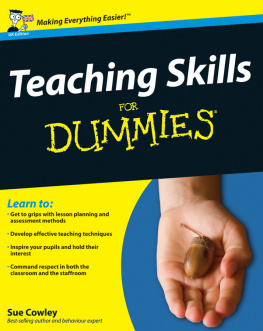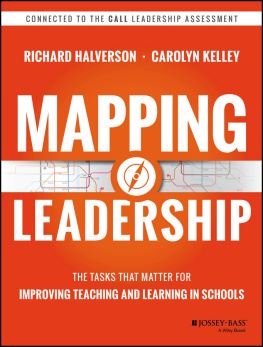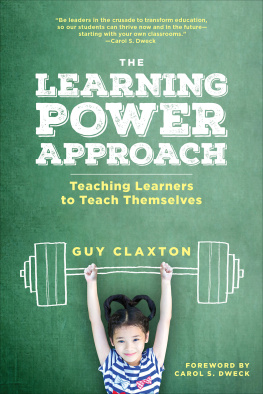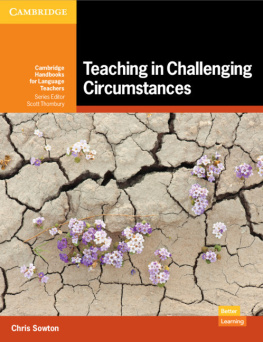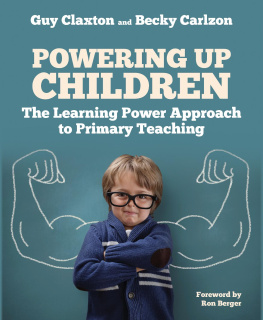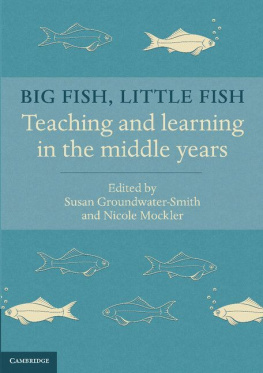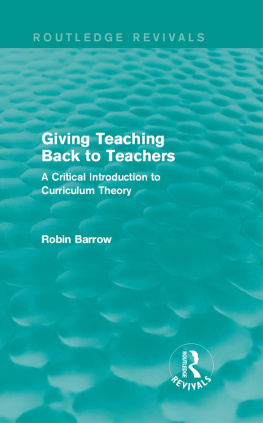
First published 2012
Published in Australia and New Zealand by ACER Press, an imprint of
Australian Council for Educational Research Ltd
19 Prospect Hill Road, Camberwell
Victoria, 3124, Australia
www.acerpress.com.au
Published in Asia by ACER Press and Routledge, Taylor & Francis Group
Published in the rest of the world by Routledge, Taylor & Francis Group
Text copyright Lynne Hunt and Denise Chalmers 2012
Design and typography copyright ACER Press 2012
This book is copyright. All rights reserved. Except under the conditions described in the Copyright Act 1968 of Australia and subsequent amendments, and any exceptions permitted under the current statutory licence scheme administered by Copyright Agency Limited (www.copyright.com.au), no part of this publication may be reproduced, stored in a retrieval system, transmitted, broadcast or communicated in any form or by any means, optical, digital, electronic, mechanical, photocopying, recording or otherwise, without the written permission of the publisher.
Every effort has been made to acknowledge and contact copyright owners. However, should an infringement have occurred, ACER tenders its apology and invites copyright owners to contact ACER.
Edited by Rebecca Leech
Indexed by Russell Brooks
Cover design, text design and typesetting by ACER Project Publishing
Cover image Pokaz, used under license from Shutterstock.com
Printed in Australia by BPA Print Group
National Library of Australia Cataloguing-in-Publication entry:
Title: | University teaching in focus : a learning-centred approach / edited by Lynne Hunt and Denise Chalmers. |
ISBN: | 9781742860312 (pbk.) |
Notes: | Includes bibliographical references and index. |
Subjects: | College teaching. |
Effective teaching. |
Classroom management. |
Educational leadership. |
Other Authors/Contributors: |
Hunt, Lynne. |
Chalmers, Denise. |
Dewey Number: | 378.125 |
FOREWORD
Mantz Yorke
University Teaching in Focus draws on a number of theoretical propositions about teaching and learning as well as evidence for the effectiveness of teaching practices. What we have here is a thinking persons guide useful, because teaching is not a simple matter that can be expressed in a set of rules applicable to all circumstances. Rather, it has to be approached in terms of a set of principles to be applied in a manner appropriate to circumstances. Some approaches are more likely to meet with success than others, but none guarantees universal success. As Hunt, Chalmers and Macdonald indicate in , Effective teaching is the outcome of decision-making based on evidence arising from research, experience of teaching students in different contexts and responses to students feedback. Good teaching takes place when teachers create positive and effective learning experiences for their students. Hence this book is much more than a set of prescriptions, as is evident from the invitations throughout its chapters to consider your own responses to the evidence.
Academics must have the double capability of discipline and teaching expertise. Whilst they possess the former as a matter of course, many will need to develop the latter and this book will help them. Of course, all academics who made their way through the educational system to get to their current positions have gained an appreciation of good and bad aspects of teaching. This can, however, lead to experience being mistaken for expertise. This book bridges the gap in ways that will help students to benefit from their programs of study. New teachers are not the only potential beneficiaries of the knowledge and expertise within the pages of this book those who have been teaching for some time are also likely to find ideas for the development of their pedagogic practice. I can truthfully say that I have.
Higher education has broadened the demands on students in that the possession of a first degree is not the passport to a career that it once was. Looking at a list of expectations produced by the Confederation of British Industry (2011), I reflected that I left university having obtained a degree but with little of the extra that employers currently demand from todays graduates. My time at university coincided with a participation rate of less than 10 per cent of the cohort of school-leavers, and the demand for graduates exceeded the supply. It was generally sufficient to pass the exams in order to gain graduate-level employment, and there was no pressure on teachers in respect of retention and completion indeed, a high failure rate was often taken as evidence of an insistence on high academic standards. If students failed their assessments, then it must have been a reflection of their personal failings and nothing to do with the teaching that they had received. Things are very different today, and governments around the world are concerned to assure the standards of teaching in higher education. This book addresses such matters of quality assurance by focusing on the knowledge and skills that higher education teachers need to facilitate student learning.
I once used the phrase quality as moral purpose (Yorke 2000, p. 21) in an unavailing attempt to turn the discourse relating to quality away from procedures and technicalities associated with assurance and towards a focus on student development. After all, if student development is got right, then the assurance activities ought to pick up the achievement. Or, put another way, the key is for the institution and its organisational units to insist on a culture of learning, and to create and sustain the conditions for this to take place. The pressure on students, teachers and institutions to achieve rapid results (for example, as represented respectively in terms of grades, progression or completion and position in ranking tables) makes sustaining a commitment to learning goals in preference to performance goals (Dweck 1999) a considerable challenge.
The challenges for todays teachers in higher education are multidimensional. In addition to teaching their academic subjects, they are expected to facilitate the development in students of a broad slew of graduate attributes (or employability). They also have to engage with a student body that is diverse in demographic background (for example, age, gender, ethnicity and disability) and mode of engagement (full-time, part-time or at a distance). The pressures are readily apparent. Resources, such as this book, that support teachers in their teaching roles have an important part to play in mitigating the pressures as well as contributing to the development of a satisfying level of expertise as a teacher.
However, teachers of today have an advantage over their predecessors, in that there is an ever-growing accumulation of evidence well represented in the chapters of this book regarding approaches that are likely to lead to success in their students. The style of this book emulates the student-centred approach espoused by providing theoretical, practical and memorable discussion to facilitate teaching and curriculum development. Angelo, for example, exhorts you to apply the parrot test: is there any way that a student could pass your subject simply through rote memorisation or by plagiarising or cheating and without demonstrating deep learning? If the answer is yes, then the subject fails the parrot test.
Next page


